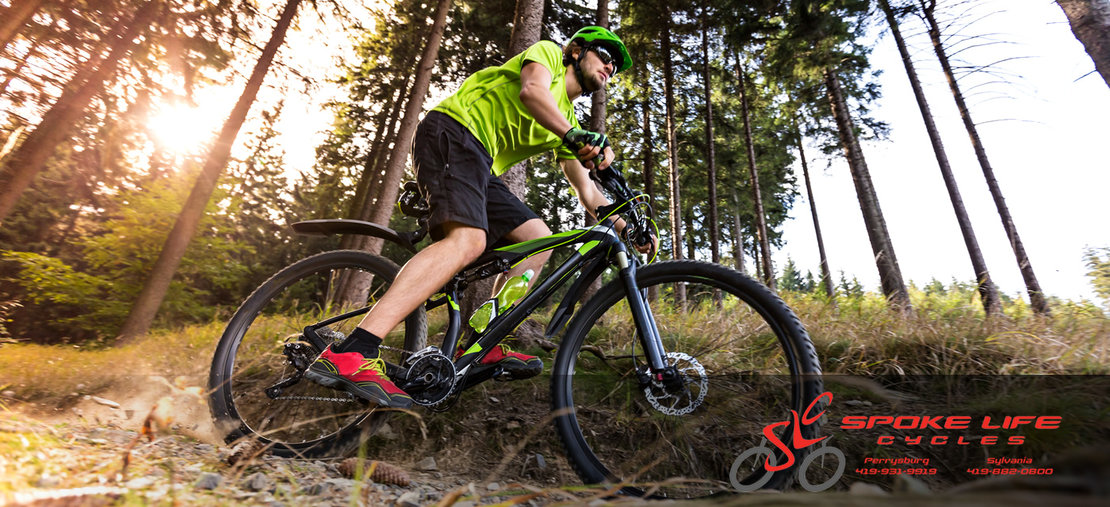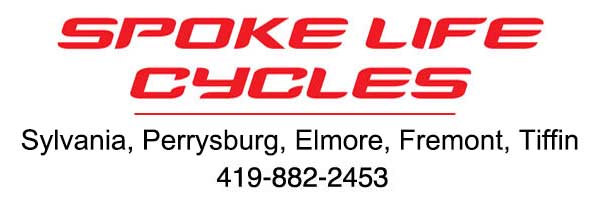Are you a mountain bike rider, or looking to get into this fun and healthy sport? Look no further than the new singletrack mountain bike trail located at Oak Openings Preserve. The trailhead is at the Springbrook area on State Route 64 just off the Wabash-Cannonball Trail. More than five miles of singletrack trail is now open to ride and explore.
Whether you are looking for your first mountain bike, or thinking of upgrading your current bike, look no further than Spoke Life Cycles with locations in Perrysburg and Sylvania.
What Type of Mountain Bike Should I Get ?
These days, mountain bikes come in all sorts of shapes and sizes. With so many options to choose from, it can be difficult to decide exactly what type of bike is right for you.
Answer: The answer to this question can depend on several factors. The most important of these factors is your personal riding preference. Probably the second most important factor is where you live.
You will find that most mountain bikes will fit into a set of fun categories:
- Cross Country (XC)
- All Mountain/Trailbikes
- Freeride, and
- Downhill (DH)
As for personal preference, you need to decide how you want to spend most of your time on your bike. Do you want to ride smooth flowing trails, climb big mountains, ride stunts, descend technical downhill courses, or just have all around fun?
Thinking about where you live and ride helps narrow your decision by making you take another realistic look at where you will be riding your bike. If you want to ride crazy downhill shuttles, but all you have is flat and smooth trails in your neck of the woods, a true downhill bike is probably not going to be your best choice.
For most people, the All Mountain /Trail Bikes category makes the most sense. These bikes are truly made to be the most fun in the largest number of situations. They can take you almost anywhere, and they won't wear you out doing it.
Cross Country (XC) bikes are the lightest and most efficient peddlers but aren't necessarily the best for rough terrain or the most comfortable.
Freeride bikes are great for hard hitting trails, jumps, and stunts. They are built to get you up the hills as well, but not very easily. These bikes are heavy and tough.
The least common bikes are the Downhill (DH) specific ones. These bikes are built just for downhill racing. Don't expect to have too much fun on these bikes without a different way to the top of the mountain, but once you are there, you won't find a faster way to get down no matter how rough the trail is.
After some consideration, most people can come to a confident decision about exactly what kind of bike is right for them. The trick is, to be honest with yourself about how you will spend most of your time riding and then Choosing a bike that is designed to make the best of it.
If you want to get a decent bike that you won’t have to spend heaps of time repairing, and one that will perform well enough that you will actually want to ride it, you’re realistically going to have to shell out around $1,000 — at the very least — for a bike.
Our key Manufacturers Cannondale, Specialized, Pivot and Salsa do offer entry level bikes that will give you a good experience on any trail and offer a lifetime warranty on the frame and 1yr warranty on components.
The #1 mountain biking safety rule is ALWAYS WEAR A HELMET.
- You need to know is that brain injuries are life altering injuries and you should do everything possible to mitigate head trauma while mountain biking, and a well designed, well fitting helmet, is an essential piece of mountain biking gear. Buy the best mountain biking helmet possible.
- Mountain biking is an inherently dangerous sport with the distinct possibility of severe injuries, or even worse. No matter where you ride or how well you know the trail you should never ride beyond your skill level, and always ride in control.
- Riding in control doesn’t just mean being able to stop, it also means having the requisite skills to recognize and avoid potential dangerous situations on the trail. You must also be able to recognize where it is safe to stop on the trail. Avoiding accidents with other riders is an essential mountain biking skill.
- Speed is one of the attractions of mountain biking and even at 15 mph you are moving at 22 feet per second and a lot can happen in 22 feet (4 bike lengths) so when you are pushing the skills envelope always be aware of the trail conditions and the potential for an accident
If you enjoy spending time on the trails you should plan and pack accordingly.
Like most tools, these items are only useful if you know how to use them. It’s always best to ride with a group, but if venturing deep into the woods alone be sure you have a few basic trail essentials like:
| - sunglasses | - tire pump | - master link |
| - helmet | - CO2 inflator | - zip ties |
| - spare tube | - tire levers | - seat bag |
| - patch kit | - multi tool | - headlight |
With these items in hand you’ll be fully prepared to tackle any trail w confidence. *Always carry a cell phone if possible*

